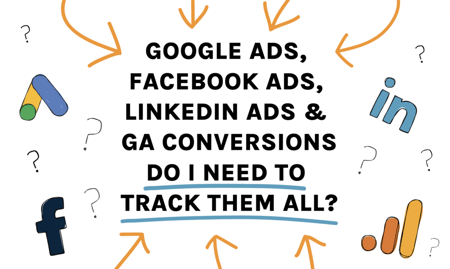Google Ads, Facebook Ads, LinkedIn Ads & GA Conversions - Do I Need to Track Them All?
November 15, 2022
5 Minute Read

With so many places online to spend money on paid media, it can be hard to keep track of everything you have running, especially during the holidays. But just because it’s a lot to handle doesn’t mean it’s not important. In this blog post, we’ll talk about which KPIs to track and why it’s important to track them.
What Is Ad Tracking?
Ad tracking refers to compiling information and user feedback on the effectiveness of digital advertising campaigns. By tracking your online ads, you can tell whether your message is effectively reaching your target audience. Ad tracking can be done by monitoring URLs, pixels, and cookies. In addition, this allows you to track performance at the campaign, ad group, keyword, creative, and audience level.
What Is the Importance of Tracking Your Paid Marketing Efforts?
Digital marketing campaigns are essential for building brand awareness and connecting with potential customers on social media platforms. By measuring the performance of your marketing efforts, you can determine what’s working, what’s not, and what to do next.
Three Reasons to Track Your Ads
- Tracking your ads’ performance gives you insight into your target demographic which can be leveraged for bid and copy optimizations.
- Ad tracking allows you to deliver a more relevant ad experience to your audience by giving you insight into how each element of the ad is performing which informs future A/B testing.
- Ad tracking shows you which actions people take on your website after clicking an ad which is useful for optimizing landing pages and user experience.
These benefits help improve your account efficiency but also provide a better experience for your target audience, all while informing strategy and next steps for other aspects of your business.
What Are the Best KPIs to Track in Your Paid Marketing Efforts?
There is no one list of PPC metrics that every business should monitor since it varies based on your industry and marketing goals. That being said, each of the following metrics provides useful information about your ads and audience and can help determine how you’re doing and what you should be doing next.
1. Conversions and Conversion Rate
A conversion occurs when a prospect or customer takes an action you are tracking after interacting with your ads. Simply said, a conversion measures the follow through on your call to action. The conversion rate reveals what proportion of those exposed to your advertisements through paid channels converted into buyers, leads, etc. Here are some ways to track your conversions across different channels:
- LinkedIn ads conversion tracking — You can use the Insight Tag or image pixel for LinkedIn ad tracking.
- Facebook ads conversion tracking — To track Facebook ads for conversion, you must have an Ads Manager account and an active or recently completed campaign. You can also use Google Analytics for Facebook ad tracking.
- Google Ads conversion tracking — To track the Google ad conversions, you can use the Google Ads Tags. Google ad tracking can also be done through Google Analytics.
Comparing conversion rates to your cost per acquisition (CPA) or the amount spent on advertising for each successful consumer action is vital. You may need to revise your ad or landing page tracking if your conversion rate rises, but your cost per acquisition (CPA) remains unchanged.
2. Click-Through Rate
The click-through rate measures the percentage of people who interact with your ads after seeing them. A higher CTR suggests that people are responding positively to your ads and aids in quality score, a measure of ad relevance and engagement. Higher quality score directly reduces the amount you need to pay per ad click which aids efficiency overall.
On the other hand, a poor click-through rate suggests that your ad isn’t resonating with searchers, meaning you’ll need to spend more money on advertising to test the right combination of keywords and wording in your ads until you find what works. While this isn’t the “end all be all” measure for PPC ads, it’s one that every marketing report should include.
3. Impressions & Reach
An impression is the number of times your ad was shown to someone. You can gauge your ads’ reach by looking at the number of impressions they receive. Depending on the platform, ads can be purchased based on cost per click or CPM (cost per thousand impressions).The greater the number of people exposed to your ads, the greater the likelihood that one will be clicked, so monitoring impressions along with clicks can provide valuable insight.
4. Quality Score
Your quality score is a function of your ad’s expected CTR as well as its relevance to the keywords and landing page associated with your ad. Since the amount you pay per click is based on quality score and the Max CPC bid you set, improving quality score lowers Avg. CPCs or earns more clicks for the same spend. Conversely, a lower score will make it more expensive to rank highly on the search results page.
5. Return on Ad Spend (ROAS)
ROAS is a measure of how much revenue you generate per dollar spent on advertisements and is a good indicator of how profitable your ad spend currently is. Typically, aiming for a higher ROAS results in lower amounts of potential revenue while lower ROAS targets allow for more volume and revenue.
If your return on ad spend drops, it may be time to rethink your landing pages, ad copy and keywords. If ROAS increases in a channel, it may be time to increase your investment in that channel relative to lower ROAS channels. You can use ROAS to learn how much more you can invest in your advertising without negatively impacting your bottom line.
6. Average Position
This indicator shows how high up on the search results page your ads appear on average. It is particularly significant for paid search ads because it helps you determine how your ads stack up against competitors and if your bids are allowing you to earn a high enough position on the page.
You want your ad to appear as high up on the page as possible when people search for terms related to your company. While a higher average position will result in more clicks, it will also require a larger advertising budget since higher bidding is required for higher positioning.
Get the Right Digital Marketing Strategy for Your Business with Be Found Online
As a marketer, you can end up wasting resources on digital advertising efforts that don’t reach the right people across the vast expanses of the Internet. Keeping tabs on the performance of your digital marketing efforts lets you fine-tune your strategies, allowing you to optimize sales this holiday season and beyond.
Be Found Online provides a one-stop shop for all your data analysis requirements. Our personalized approach ensures that your digital marketing efforts will always be ahead of the competition. Contact Us Today to learn how to create the perfect digital marketing strategy for your business!

Curtiss Gulash
When Curtiss is not being a Brewmeister, brewing amazing craft beers at Big Cat Brewing Company, in Cedar, Michigan, he is BFO’s Paid Media Team Lead with a specialty in marketing automotive brands. Curtiss is known for his super-human energy and loves taking a project from start to completion. He understands the world of digital media through and through and manages to juggle multiple curveballs, be a terrific team player, and a super coach to his staff.
CATEGORIES
SUBSCRIBE TO OUR BLOG
Stay up to date with the latest industry best practices in digital marketing!























.png?width=339&height=179&name=Webinar%20Banner%20(1).png)



.png?width=339&height=179&name=July%20Webinar%20(Newsletter).png)

.png?width=339&height=179&name=Webinar%20Banner-April-02%20(1).png)
%20(4).png?width=339&height=179&name=Webinar%20Banner-May-02%20(1)%20(4).png)




.png?width=339&height=179&name=March%202023%20Webinar%20Ad%20(autoresponder).png)

















































